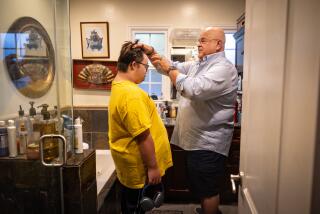Record Number of Jobs Found for Handicapped
- Share via
Looking for a job isn’t easy for anyone, but it’s even harder for someone like David Lichtenstein, a 28-year-old college graduate who has cerebral palsy.
He looked for two years before getting a job offer that he reluctantly turned down because he would not have earned enough to compensate for the loss of government benefits. But the persistent Lichtenstein finally found a consulting job at Northridge Hospital Medical Center, and help from the state Department of Rehabilitation made it economically feasible for him to accept it.
Lichtenstein bought a van, and in February the department paid to modify it so he could drive to work.
“I didn’t want to end up sitting at home, watching soap operas, eating Oreos and counting the computer holes in my government check,” Lichtenstein said.
It turned out to be a good year for Lichtenstein and a history-making one for the department, statewide and in its Van Nuys office.
16,614 Jobs Found
The consultant from Sepulveda is one of 16,614 people the Department of Rehabilitation helped place in jobs during the fiscal year that ended June 30. This figure signaled a milestone for the agency, which in its 64 years had never placed so many physically and mentally disabled people. By comparison, in fiscal 1983-84, 14,343 clients were added to payrolls. The workers range from people born with handicaps to accident victims and people with mental disorders.
The agency’s Van Nuys office also completed a banner year, with 733 of its clients obtaining jobs, up from 574 the previous year.
In 1983-84, the Van Nuys office finished last among the department’s 19 local rehabilitation offices in the number of placements. This year, Van Nuys inched up to 11th place, and its director, John Millen, expects the climb to continue.
Morale Boost Cited
Millen attributes the rise, in part, to higher morale among the rehabilitation counselors, 80% of whom increased the number of clients they helped to place.
“I think our staff really pulled together and began to put on an exceptionally good effort in serving people,” said Millen, who was part of a new management team that took over a year and half ago.
State officials offer numerous other reasons for increased job placements this year, including the maturing of employment programs aimed at preparing clients for work while making it more convenient for employers to hire the handicapped.
One such program provides employers with a tax credit for up to half of the first $6,000 earned by a disabled worker. Another program has established 50 private industry councils that try to encourage employers to hire qualified handicapped people.
Michael Newman, a program supervisor in the Van Nuys office, said that more handicapped people are being placed partly because some employers have become more willing to hire qualified disabled workers.
“I’ve seen a growing awareness on the part of employers that the disabled make good workers,” Newman said.
For instance, the McDonald’s fast-food chain recently began a training program for the handicapped in the San Fernando Valley called McJobs. McDonald’s has hired a dozen people after the two 10-week training programs held so far. McDonald’s holds big graduation ceremonies, complete with caps and gowns, to help instill a sense of accomplishment in the students.
Alan Abrams, a program supervisor in Van Nuys who attended the ceremonies, said, “I’ve heard parents say, ‘I never thought this day would come.’ ”
In addition, the Safeway supermarket chain, which has been actively recruiting handicapped people in Northern California in conjunction with state agencies for some time, has set up the same program in Los Angeles. A Safeway representative spends one day a week at a Valley office of the Department of Employment Development to screen potential candidates.
Job counselors also attribute the state’s success to the spunk of clients like Lichtenstein, who as part of his job is compiling resource books for the handicapped at Northridge Hospital’s medical library. The books contain obscure but valuable information, such as whether bathrooms are accessible to wheelchairs on the boats to Catalina Island.
Economic Benefits
The economic benefits derived from preparing disabled people for employment are considerable. Before the Department of Rehabilitation helped place them in their jobs, the 16,614 people received a total of $14 million annually in income, much of it from the government. The department estimates that with their employment, those people’s earning power has grown to $170 million a year.
“It’s quite a record for the department, considering we have less counselors now than we did two years back,” said Cecie Fontanoza, the statewide rehabilitation agency’s director. “Their morale is up, their goal is clear.”
At the same time, however, the agency is facing one of its biggest challenges as it deals with an increasing number of disabled people who need and want jobs. With Americans living longer, more are becoming disabled while they are in the work force, Fontanoza said. The state estimates that by 1990, one out of 10 Californians will be disabled, she said.
What can the agency do to help make the client marketable?
If necessary, it will pay for schooling, trade tools, modification of a vehicle and even a haircut to prepare disabled applicants for jobs.
“We can do just about anything that can make sense to get someone to work,” Millen said.
Successful Case
Take the case of a 29-year-old woman who has spina bifida--a congenital defect in the spine--and mental problems stemming from her disability. For several years, the woman worked at short-term clerical jobs until rehabilitation staffers newly assigned to her case discovered that she could type only seven words a minute.
Her job consultant, who asked that the woman’s name not be used, found a typewriter and enrolled the client in an intensive typing course. However, she began getting parking tickets because she could not afford the $5 fee to park in a garage. A rehabilitation staffer interceded and persuaded the owner of the garage to let her park free.
The woman now types 45 words a minute, is in good spirits and appears to have a good chance of getting a permanent job in a government office, said her job consultant, Lois Hurley.
When a woman with multiple sclerosis was about to be disqualified from a receptionist job at a Valley law firm because she did not have the strength to push her wheelchair across the office’s thick pile carpet, the state replaced her manual chair with an electric one.
Computer Keyboard Altered
If necessary, the state will pay to adjust a work site to fit a handicapped person’s abilities. That is what happened when a 20-year employee of the Internal Revenue Service was in danger of losing his analyst job because a muscular disease prevented him from reaching the entire keyboard of his computer. Clarence Nicodemus, a rehabilitation engineer contracted by the state, redesigned the computer so the keyboard could be positioned within the man’s reach.
Nicodemus also helped a partially paralyzed client make sure a foot-controlled steering wheel would fit into the compact car the client wanted to buy. For another partially paralyzed man, Nicodemus rigged a special shower stall--a mission that came under the department’s purview because a person who smells bad has difficulty keeping a job.
In its quest to find more jobs, the agency in Van Nuys also is seeking help from unlikely sources. In connection with the Department of Corrections, the rehabilitation department is using white-collar criminals who must perform community service work. The parolees attempt to assist in the placement of handicapped individuals by relying on their contacts in the business grapevine. The program is too new, though, to assess whether it will work.
More to Read
Sign up for Essential California
The most important California stories and recommendations in your inbox every morning.
You may occasionally receive promotional content from the Los Angeles Times.













